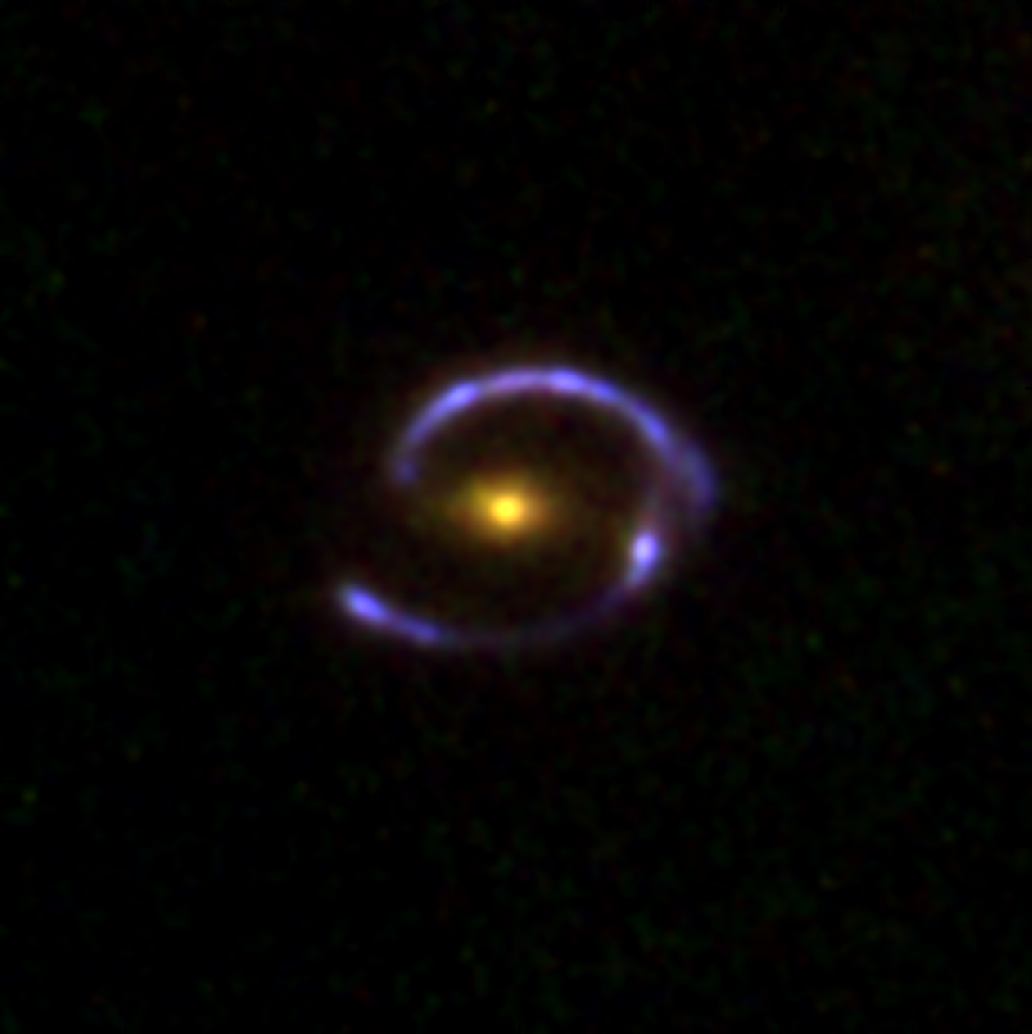[/caption]
Using gravitational lensing, astronomers have been able to see a young star-forming galaxy in the distant universe as it appeared only two billion years after the Big Bang. Appropriately enough, the galaxy used as a zoom lens was the “Cosmic Eye” galaxy, named so because through the effect of gravitational lensing, it looks like a giant eye in space. The researchers, led by Dr. Dan Stark, of Caltech, say this distant galaxy may provide insights into how our own galaxy may have evolved to its present state.
The astronomers used the ten meter Keck telescope in Hawaii, which is equipped with a laser-assisted guide star adaptive optics (AO) to correct for blurring in the Earth’s atmosphere. By combining the powerful telescope with the magnifying effect of the gravitational field of the foreground galaxy – called gravitational lensing – they were able to study the distant star system, which lies 11 billion light years from Earth. The Cosmic Eye, the foreground galaxy, is 2.2 billion light years from Earth.
The distortion of light rays enlarged the distant galaxy eight times.
This allowed the scientists to determine the galaxy’s internal velocity structure and compare it to later star systems such as the Milky Way.
In the image, the red source in the middle is the foreground lensing galaxy, while the blue ring is the near-complete ring image of the background star-forming galaxy.
Watch a movie of the gravitational lensing view.
Research co-author Dr. Mark Swinbank, in The Institute for Computational Cosmology, at Durham University, said, “This is the most detailed study there has been of an early galaxy. Effectively we are looking back in time to when the Universe was in its very early stages.
Stark said, “Gravity has effectively provided us with an additional zoom lens, enabling us to study this distant galaxy on scales approaching only a few hundred light years.
“This is ten times finer sampling than previously. As a result for the first time we can see that a typical-sized young galaxy is spinning and slowly evolving into a spiral galaxy much like our own Milky Way.”
Data from the Keck Observatory was combined with millimeter observations from the Plateau de Bure Interferometer, in the French Alps, which is sensitive to the distribution of cold gas destined to collapse to form stars.
Dr. Swinbank added, “Remarkably the cold gas traced by our millimetre observations shares the rotation shown by the young stars in the Keck observations.
“The distribution of gas seen with our amazing resolution indicates we are witnessing the gradual build up of a spiral disk with a central nuclear component.”
These observations has astronomers looking forward to the capabilities of the European Extremely Large Telescope (E -ELT) and the American Thirty Metre Telescope (TMT), which are being built and will be available in about 10 years.
Source: Durham University


A short , discovery paper on this weird system (aka LBG J213512.73-010143 , a Lyman Break Galaxy with a redshift of 3.07) was posted at arXiv:astro-ph/0611486 for Nov 15, 2006. It includes HST images & Keck spectra to help determine the physical characteristics of both the lensing galaxy (at a redshift of 0.73) & the magnified image of the LBG. Lensed systems such as this one can give astronomers valuable information on distant, forming galactic systems that would otherwise prove too faint to accurately examine due to their great distance. Websites such as the Strong Lenses COSMOS Page at http://cosmosstronglensing.uni-hd.de/ provide current images & info on these rare and unusual gravitational lenses and are frequently updated with current info & newly discovered objects. These systems not only provide good sources of information on chemical abundances, star formation rates and other physical characteristics of the lensed galaxies, but can also provide info on Dark Matter distribution in the lensing galaxies themselves. These systems are sure to be examined in detail across the entire electromagnetic spectrum in the coming years.
A related search for lensed quasars, the SDSS Quasar Lens Search( SQLS ) can be found at http://www-utap.phys.s.u-tokyo.ac.jp/~sdss/sqls/index.html . Similar to the Strong Lenses COSMOS Page, current images & info on lensed quasars can be found here and the site is updated periodically with links to new images, info & newly discovered systems of this type. Both sites are highly recommended for those interested in gravitationally lensed systems and current research being performed on them.
Thanks to Jon Hanford for the lens links. They seem like good sources to help keep track of new developments in dark matter and other cosmological questions.